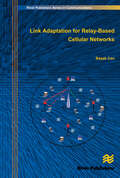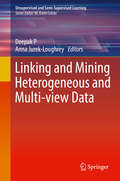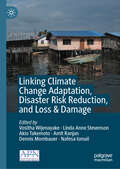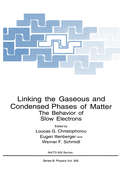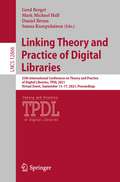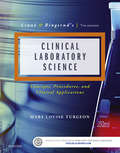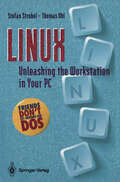- Table View
- List View
Linienführung: II. Teil. Eisenbahnwesen und Städtebau (Handbibliothek für Bauingenieure #2)
by Erich Giese Otto Blum Kurt RischDieser Buchtitel ist Teil des Digitalisierungsprojekts Springer Book Archives mit Publikationen, die seit den Anfängen des Verlags von 1842 erschienen sind. Der Verlag stellt mit diesem Archiv Quellen für die historische wie auch die disziplingeschichtliche Forschung zur Verfügung, die jeweils im historischen Kontext betrachtet werden müssen. Dieser Titel erschien in der Zeit vor 1945 und wird daher in seiner zeittypischen politisch-ideologischen Ausrichtung vom Verlag nicht beworben.
Linienführung elektrischer Bahnen
by Karl TrautvetterDieser Buchtitel ist Teil des Digitalisierungsprojekts Springer Book Archives mit Publikationen, die seit den Anfängen des Verlags von 1842 erschienen sind. Der Verlag stellt mit diesem Archiv Quellen für die historische wie auch die disziplingeschichtliche Forschung zur Verfügung, die jeweils im historischen Kontext betrachtet werden müssen. Dieser Titel erschien in der Zeit vor 1945 und wird daher in seiner zeittypischen politisch-ideologischen Ausrichtung vom Verlag nicht beworben.
Link Adaptation for Relay-Based Cellular Networks
by Basak CanCover TextLink Adaptation for Relay-Based Cellular Networks focuses on the implementation of various link adaptation methods in OFDM(A) (Orthogonal Frequency Division Multiplexing/Multiple Access)?Time Division Duplex (TDD) based two-hop cellular networks. The analysis and design consider infrastructure based relays. New link adaptive transmission methods which dynamically select the channel coding, modulation, forwarding, relaying mechanisms and the packet size have been designed and evaluated for such networks. The selection among various schemes is based on maximizing the end-to-end throughput.This book provides a channel adaptive scheduler which considers the multiplexing loss caused by the two-phase nature of wireless relaying. The scheduler dynamically schedules the users on the frequency-time radio resources with efficient Modulation and Coding Schemes (MCS)s selected by Adaptive Modulation and Coding (AMC). Relaying is used only if it can provide throughput enhancement. The guidelines for efficient deployment of infrastructure based relay terminals are given. For the two-hop cellular communication systems, the system level performance of various cooperative diversity schemes has been investigated with the scheduler developed and the relays efficiently deployed in the cell. This investigation for low mobility scenarios shows that, a simple cooperative diversity scheme that dynamically chooses the best scheme among direct transmission and two-hop conventional relaying is a promising choice when compared to various more complex cooperative diversity schemes.In this book, a hop adaptive Medium Access Control (MAC)-Protocol Data Unit (PDU) size optimization is proposed for wireless relay networks.
Link Adaptation for Relay-Based Cellular Networks
by Basak CanCover TextLink Adaptation for Relay-Based Cellular Networks focuses on the implementation of various link adaptation methods in OFDM(A) (Orthogonal Frequency Division Multiplexing/Multiple Access)?Time Division Duplex (TDD) based two-hop cellular networks. The analysis and design consider infrastructure based relays. New link adaptive transmission methods which dynamically select the channel coding, modulation, forwarding, relaying mechanisms and the packet size have been designed and evaluated for such networks. The selection among various schemes is based on maximizing the end-to-end throughput.This book provides a channel adaptive scheduler which considers the multiplexing loss caused by the two-phase nature of wireless relaying. The scheduler dynamically schedules the users on the frequency-time radio resources with efficient Modulation and Coding Schemes (MCS)s selected by Adaptive Modulation and Coding (AMC). Relaying is used only if it can provide throughput enhancement. The guidelines for efficient deployment of infrastructure based relay terminals are given. For the two-hop cellular communication systems, the system level performance of various cooperative diversity schemes has been investigated with the scheduler developed and the relays efficiently deployed in the cell. This investigation for low mobility scenarios shows that, a simple cooperative diversity scheme that dynamically chooses the best scheme among direct transmission and two-hop conventional relaying is a promising choice when compared to various more complex cooperative diversity schemes.In this book, a hop adaptive Medium Access Control (MAC)-Protocol Data Unit (PDU) size optimization is proposed for wireless relay networks.
Link-Layer Cooperative Communication in Vehicular Networks (Wireless Networks)
by Sailesh Bharati Weihua ZhuangThis book presents link-layer cooperative frameworks to improve transmission reliability and network throughput of distributed TDMA MAC protocols in vehicular ad hoc networks (VANETs). The main objective of this book is to present link-layer node cooperation schemes to enhance the link-layer performance of vehicular networks, in terms of reliability and system throughput. The authors present approaches proposed for the medium access control (MAC) and node cooperation in VANETs. The authors also cover cooperative ADHOC MAC for point-to-point communication between a pair of source and destination nodes, and cooperative relay broadcasting for broadcast services in this book. The performance of node cooperation frameworks is evaluated via mathematical analysis and computer simulations, in comparison with distributed TDMA MAC protocols without cooperation. The proposed node cooperation frameworks enhance the performance of distributed TDMA MAC and make it more robust to tackle the dynamic networking conditions in VANETs. Furthermore, with cooperation enabled transmission, the performance of distributed TMDA MAC is more suitable to support the wide range of mobile applications and their strict service requirements which is discussed in this book. The proposed node cooperation schemes and distributed cooperation decisions can be extended to wireless systems other than distributed TDMA MAC, such as cellular communication, for vehicular communications introduced in this book. This book is useful for researchers from academia and industry, as well as advanced level students interested in vehicular communication networks. It is also useful for professionals and engineers developing applications that use cooperative wireless communication systems.
Linkage in Evolutionary Computation (Studies in Computational Intelligence #157)
by Ying-Ping ChenIn recent years, the issue of linkage in GEAs has garnered greater attention and recognition from researchers. Conventional approaches that rely much on ad hoc tweaking of parameters to control the search by balancing the level of exploitation and exploration are grossly inadequate. As shown in the work reported here, such parameters tweaking based approaches have their limits; they can be easily ”fooled” by cases of triviality or peculiarity of the class of problems that the algorithms are designed to handle. Furthermore, these approaches are usually blind to the interactions between the decision variables, thereby disrupting the partial solutions that are being built up along the way.
Linking and Mining Heterogeneous and Multi-view Data (Unsupervised and Semi-Supervised Learning)
by Deepak P Anna Jurek-LoughreyThis book highlights research in linking and mining data from across varied data sources. The authors focus on recent advances in this burgeoning field of multi-source data fusion, with an emphasis on exploratory and unsupervised data analysis, an area of increasing significance with the pace of growth of data vastly outpacing any chance of labeling them manually. The book looks at the underlying algorithms and technologies that facilitate the area within big data analytics, it covers their applications across domains such as smarter transportation, social media, fake news detection and enterprise search among others. This book enables readers to understand a spectrum of advances in this emerging area, and it will hopefully empower them to leverage and develop methods in multi-source data fusion and analytics with applications to a variety of scenarios.Includes advances on unsupervised, semi-supervised and supervised approaches to heterogeneous data linkage and fusion; Covers use cases of analytics over multi-view and heterogeneous data from across a variety of domains such as fake news, smarter transportation and social media, among others;Provides a high-level overview of advances in this emerging field and empowers the reader to explore novel applications and methodologies that would enrich the field.
Linking Climate Change Adaptation, Disaster Risk Reduction, and Loss & Damage (Sustainable Development Goals Ser.)
by Linda Anne Stevenson Amit Ranjan Dennis Mombauer Vositha Wijenayake Akio Takemoto Nafesa IsmailThis book advances knowledge on loss & damage (L&D) and its interlinkages with climate adaptation and disaster risk reduction. The book includes twelve case studies conducted across South and Southeast Asia, covering sectors including agriculture, rural livelihoods, energy, infrastructure and natural resources. These studies provide insights into complex climate-induced L&D, enhancing local, national and regional knowledge and contributing to global agendas.
Linking Models and Experiments, Volume 2: Proceedings of the 29th IMAC, A Conference on Structural Dynamics, 2011 (Conference Proceedings of the Society for Experimental Mechanics Series #4)
by Tom ProulxLinking Models and Experiments, Volume 2. Proceedings of the 29th IMAC, A Conference and Exposition on Structural Dynamics, 2011, the second volume of six from the Conference, brings together 33 contributions to this important area of research and engineering. The collection presents early findings and case studies on fundamental and applied aspects of Structural Dynamics, including papers on Finite Element Techniques, Model Updating, Experimental Dynamics Substructuring, Model Validation, and Uncertainty Quantification.
Linking People, Place, and Policy: A GIScience Approach
by Stephen J. Walsh and Kelley A. Crews-MeyerLinking People, Place, and Policy: A GIScience Approach describes a breadth of research associated with the study of human-environment interactions, with particular emphasis on land use and land cover dynamics. This book examines the social, biophysical, and geographical drivers of land use and land cover patterns and their dynamics, which are interpreted within a policy-relevant context. Concepts, tools, and techniques within Geographic Information Science serve as the unifying methodological framework in which landscapes in Thailand, Ecuador, Kenya, Cambodia, China, Brazil, Nepal, and the United States are examined through analyses conducted using quantitative, qualitative, and image-based techniques. Linking People, Place, and Policy: A GIScience Approach addresses a need for a comprehensive and rigorous treatment of GIScience for research and study within the context of human-environment interactions. The human dimensions research community, land use and land cover change programs, and human and landscape ecology communities, among others, are collectively viewing the landscape within a spatially-explicit perspective, where people are viewed as agents of landscape change that shape and are shaped by the landscape, and where landscape form and function are assessed within a space-time context. This book articulates some of these challenges and opportunities.
Linking Research and Marketing Opportunities for Pulses in the 21st Century: Proceedings of the Third International Food Legumes Research Conference (Current Plant Science and Biotechnology in Agriculture #34)
by R. KnightLinking Restoration and Ecological Succession (Springer Series on Environmental Management)
by Lawrence R. Walker Joe Walker Richard J. HobbsThis innovative book integrates practical information from restoration projects around the world with the latest developments in successional theory. It recognizes the critical roles of disturbance ecology, landscape ecology, ecological assembly, invasion biology, ecosystem health, and historical ecology in habitat restoration. It argues that restoration within a successional context will best utilize the lessons from each of these disciplines.
Linking the Gaseous and Condensed Phases of Matter: The Behavior of Slow Electrons (Nato Science Series B: #326)
by Loucas G. Christophorou Eugen Illenberger Werner F. SchmidtThe Advanced Study Institute (ASI) on "Linking the Gaseous and Condensed Phases of Matter: The Behavior of Slow Electrons" was held at Patras, Greece, September 5-18, 1993. The organizers of the Patras ASI felt that the study of the electronic properties of matter in various states of aggregation has advanced to a point where further progress required the interfacing of the phases of matter in order to find out and to understand how the microscopic and macroscopic properties of materials and processes change as we go from low pressure gas to the condensed phase. This approach is of foremost significance both from the point of view of basic research and of applications. Linking the electronic properties of the gaseous and condensed phases of matter is a fascinating new frontier of science embracing scientists not only from physics and chemistry but also from the life sciences and engineering. The Patras ASI brought together some of the world's foremost experts who work in the field of electronic properties of molecular gases, clusters, liquids, and solids. The thirty five lectures given at the meeting as well as the twenty nine poster papers presented and the formal and informal discussions that took place focused largely on the behavior of slow electrons in matter.
Linking the Space Shuttle and Space Stations: Early Docking Technologies from Concept to Implementation (Springer Praxis Books)
by David J. ShaylerHow could the newly authorized space shuttle help in the U.S. quest to build a large research station in Earth orbit? As a means of transporting goods, the shuttle could help supply the parts to the station. But how would the two entitles be physically linked?Docking technologies had to constantly evolve as the designs of the early space stations changed. It was hoped the shuttle would make missions to the Russian Salyut and American Skylab stations, but thesewere postponed until the Mir station became available, while plans for getting a new U. S. space station underway were stalled.In Linking the Space Shuttle and Space Stations, the author delves into the rich history of the Space Shuttle and its connection to these early space stations, culminating in the nine missions to dock the shuttle toMir. By 1998, after nearly three decades of planning and operations, shuttle missions to Mir had resulted in:• A proven system to link up the space shuttle to a space station• Equipment and hands-on experience in handling tons of materials• An infrastructure to support space station assembly and resupplyEach of these played a pivotal role in developing the skills and procedures crucial to the creation of the later, much larger and far more complex International Space Station, as described in the companionvolume Assembling and Supplying the ISS: The Space Shuttle Fulfills Its Mission.
Linking Theory and Practice of Digital Libraries: 25th International Conference on Theory and Practice of Digital Libraries, TPDL 2021, Virtual Event, September 13–17, 2021, Proceedings (Lecture Notes in Computer Science #12866)
by Gerd Berget Mark Michael Hall Daniel Brenn Sanna KumpulainenThis book constitutes the proceedings of the 25th International Conference on Theory and Practice of Digital Libraries, TPDL 2021, held in September 2021. Due to COVID-10 pandemic the conference was held virtually.The 10 full papers, 3 short papers and 13 other papers presented were carefully reviewed and selected from 53 submissions. TPDL 2021 attempts to facilitate establishing connections and convergences between diverse research communities such as Digital Humanities, Information Sciences and others that could benefit from ecosystems offered by digital libraries and repositories. This edition of TPDL was held under the general theme of “Linking Theory and Practice”. The papers are organized in topical sections as follows: Document and Text Analysis; Data Repositories and Archives; Linked Data and Open Data; User Interfaces and Experience.
Linne & Ringsrud's Clinical Laboratory Science - E-Book: The Basics and Routine Techniques
by Mary Louise TurgeonUsing a discipline-by-discipline approach, Linne & Ringsrud's Clinical Laboratory Science: Concepts, Procedures, and Clinical Applications, 7th Edition provides a fundamental overview of the skills and techniques you need to work in a clinical laboratory and perform routine clinical lab tests. Coverage of basic laboratory techniques includes key topics such as safety, measurement techniques, and quality assessment. Clear, straightforward instructions simplify lab procedures, and are described in the CLSI (Clinical and Laboratory Standards Institute) format. Written by well-known CLS educator Mary Louise Turgeon, this text includes perforated pages so you can easily detach procedure sheets and use them as a reference in the lab!Hands-on procedures guide you through the exact steps you'll perform in the lab.Review questions at the end of each chapter help you assess your understanding and identify areas requiring additional study.A broad scope makes this text an ideal introduction to clinical laboratory science at various levels, including CLS/MT, CLT/MLT, and Medical Assisting, and reflects the taxonomy levels of the CLS/MT and CLT/MLT exams.Detailed full-color illustrations show what you will see under the microscope.An Evolve companion website provides convenient online access to all of the procedures in the text, a glossary, audio glossary, and links to additional information.Case studies include critical thinking and multiple-choice questions, providing the opportunity to apply content to real-life scenarios.Learning objectives help you study more effectively and provide measurable outcomes to achieve by completing the material.Streamlined approach makes it easier to learn the most essential information on individual disciplines in clinical lab science.Experienced author, speaker, and educator Mary Lou Turgeon is well known for providing insight into the rapidly changing field of clinical laboratory science.Convenient glossary makes it easy to look up definitions without having to search through each chapter. NEW! Procedure worksheets have been added to most chapters; perforated pages make it easy for students to remove for use in the lab and for assignment of review questions as homework.NEW! Instrumentation updates show new technology being used in the lab. NEW! Additional key terms in each chapter cover need-to-know terminology.NEW! Additional tables and figures in each chapter clarify clinical lab science concepts.
Linne & Ringsrud's Clinical Laboratory Science E-Book: Concepts, Procedures, and Clinical Applications
by Mary Louise TurgeonThoroughly updated and easy-to-follow, Linne & Ringsrud's Clinical Laboratory Science: Concepts, Procedures, and Clinical Applications, 8th Edition offers a fundamental overview of the laboratory skills and techniques you’ll need for success in the clinical laboratory. Author Mary Louise Turgeon's simple and straightforward writing clarifies complex concepts, and her unique discipline-by-discipline approach helps you build knowledge and learn to confidently perform routine clinical laboratory tests with accurate, effective results. Topics like safety, measurement techniques, and quality assessment are woven throughout the various skills. The new eighth edition also features updated content including expanded information on viruses and automation. It’s the must-have foundation for anyone wanting to pursue a profession in the clinical lab.Broad content scope provides an ideal introduction to clinical laboratory science at a variety of levels, including CLS/MT, CLT/MLT, and Medical Assisting.Case studies include critical thinking and multiple-choice questions to challenge readers to apply the content to real-life scenarios.Expert insight from respected educator Mary Lou Turgeon reflects the full spectrum of clinical lab science.Detailed procedures guides readers through the exact steps performed in the lab.Vivid full-color illustrations familiarize readers with what they’ll see under the microscope.Review questions at the end of each chapter help readers assess your understanding and identify areas requiring additional study.Evolve companion website provides convenient online access to all of the procedures in the text and houses animations, flashcards, and additional review questions not found in the printed text. Procedure worksheets can be used in the lab and for assignment as homework.Streamlined approach makes must-know concepts and practices more accessible.Convenient glossary simplifies the process of looking up definitions without having to search through each chapter.NEW! Updated content throughout keeps pace with constant changes in clinical lab science.NEW! Consistent review question format ensures consistency and enables readers to study more efficiently. NEW! More discussion of automation familiarizes readers with the latest automation technologies and processes increasingly used in the clinical lab to increase productivity and elevate experimental data quality.NEW! Additional information on viruses keeps readers up to date on this critical area of clinical lab science.
LINUX: Unleashing the Workstation in Your PC
by Stefan Strobel Thomas UhlUNIX achieved its widespread propagation, its penetration of the UNIX history university domain, and its reach into research and industry due to its early dissemination by AT&T to all interested parties at almost no cost and as source code. UNIX's present functionality emanated not just from AT&T developers but also from external developers who used the product and contributed their own further developments, which they then put at AT&T's disposal. (Consider the contributions of the University of California at Berkeley, for example.) With the rising commercialization of UNIX by AT&T (now by Novell) since 1983, such creative and cooperative further development became increasingly restricted, and UNIX source code today has become unaffordably expensive and scarcely accessible. Linux provides interested computer scientists and us"ers with a system that revives the old UNIX tradition: Linux is available for free, and everyone is heartily invited (but not obliged) to free & participatory contribute to its further development. Since Linux runs on PC systems, it has begun to penetrate the workrooms of many computer science students and computer freaks.
Linux vom PC zur Workstation: Grundlagen, Installation und praktischer Einsatz
by Stefan Strobel Thomas UhlLINUX, ein relativ neues UNIX-System für PCs hat sich in den letzten Monaten immer mehr zu einer Alternative zu kommerziellen Systemen entwickelt. Mit diesem LINUX-PowerPack erhalten Sie alles, was Sie benötigen, um Ihren PC in eine leistungsfähige UNIX-Workstation zu verwandeln.
LINUX Vom PC zur Workstation: Grundlagen, Installation und praktischer Einsatz
by Stefan Strobel Thomas UhlLINUX Vom PC zur Workstation: Grundlagen, Installation und praktischer Einsatz
by Stefan Strobel Thomas UhlPraxisbezogen mit vielen Beispielen werden neben den wichtigsten Grundlagen und Konzepten von UNIX die Beschaffung, Installation und Konfiguration von LINUX beschrieben. Schwerpunkte bilden dabei die graphische Oberfläche, die Netzwerkfähigkeit und die Tools des GNU-Projekts. Außerdem sind Entwicklungsumgebung, LINUX-Applikationen und LINUX-Kommandos enthalten.
Lion: A Long Way Home
by Saroo BrierleyNOMINATED FOR SIX OSCARS, INCLUDING BEST PICTURE, SUPPORTING ACTOR AND SUPPORTING ACTRESS . . . Aged just five, Saroo Brierley lost all contact with his family in India, after waiting at a train station for his brother who never returned. Discover the inspiring, true story behind the film, Lion. This is the heart breaking and original tale of the lost little boy who found his way home twenty-five years later. ----------------------------------- As a five-year old in India, I got lost on a train. Twenty-five years later, I crossed the world to find my way back home. Five-year-old Saroo lived in a poor village in India, in a one-room hut with his mother and three siblings... until the day he boarded a train alone and got lost. For twenty-five years. This is the story of what happened to Saroo in those twenty-five years. How he ended up on the streets of Calcutta. And survived. How he then ended up in Tasmania, living the life of an upper-middle-class Aussie. And how, at thirty years old, with some dogged determination, a heap of good luck and the power of Google Earth, he found his way back home. Lion is a triumphant true story of survival against all odds and a shining example of the extraordinary feats we can achieve when hope endures.----------------------------------- 'Amazing stuff' The New York Post 'So incredible that sometimes it reads like a work of fiction' Winnipeg Free Press (Canada) 'A remarkable story' Sydney Morning Herald Review 'I literally could not put this book down. Saroo's return journey will leave you weeping with joy and the strength of the human spirit' Manly Daily (Australia) 'We urge you to step behind the headlines and have a read of this absorbing account...With clear recollections and good old-fashioned storytelling, Saroo...recalls the fear of being lost and the anguish of separation' Weekly Review (Australia)
Lipid and Biopolymer Monolayers at Liquid Interfaces
by K.S. BirdiDuring the past few decades, much research has been reported on the formation of insoluble monomolecular films of lipids and biopolymers (synthetic polymers and proteins) on the surface of water or at the oil-water interface. This interest arises from the fact that monomolecular film studies have been found to provide much useful information on a molecular scale, information that is useful for understanding many industrial and biological phenomena in chemical, agricultural, pharmaceutical, medical, and food science applications. For instance, information obtained from lipid monolayer studies has been useful in determining the forces that are known to stabilize emulsions and biological cell membranes. The current texts on surface chemistry generally devote a single chapter to the characteristics of spread monolayers of lipids and biopolymers on liquids, and a researcher may have to review several hundred references to determine the procedures needed to investigate or analyze a particular phenomenon. Furthermore, there is an urgent need at this stage for a text that discusses the state of the art regarding the surface pheqomena exhibited by lipids and biopolymers, as they are relevant to a wide variety of surface and interfacial processes.
Lipid and Polymer-Lipid Systems (Progress in Colloid and Polymer Science #120)
by T. Nylander B. LindmanThe renewed and increasing interest in lipid self-assembly, phase behaviour and interfacial properties can be related to both a much improved insight in biological systems and the applications of lipids in food and pharmaceutical industry; in the latter, the development of drug delivery systems based on lipids has become in focus. Amphiphilic systems comprise lipids, surfactants as well as different types of polymers, including block and graft copolymers. Research on biological amphiphiles has often been conducted separate from research on synthetic ones. However, in recent years a very fruitful convergence between the two fields has evolved. These new perspectives on fundamental research and applications of lipids are discussed in these proceedings from an international symposium on "Lipid and Polymer Lipid-systems", October 2000 in Chia Laguna in Italy - a joint undertaking of Prof. Maura Monduzzi at Cagliari University, Italy and Camurus Lipid Research Foundation, Lund, Sweden.


